 W
WThe Atlantic Forest climbing mouse is an arboreal rodent species in the family Cricetidae from South America. It is found in the Atlantic Forest of southeastern Brazil at elevations from sea level to 1500 m. Its karyotype is 2n = 44, FN = 74–80.
 W
WThe Australian swamp rat, also known as the eastern swamp rat, is a species of rat native to the coasts of southern and eastern Australia.
 W
WThe black-bearded tomb bat is a species of sac-winged bat. It is found in South and South East Asia.
 W
WThe black-footed gray langur is an Old World monkey, one of the species of langurs. This, like other gray langurs, is a leaf-eating monkey found in south India.
 W
WThe booted macaque is a macaque of the Sulawesi Island, Indonesia. This Old World monkey is diurnal and spends most of the day in the trees. It is 50–59 cm long plus a tail of 35–40 cm.
 W
WThe bridled nail-tail wallaby, also known as the bridled nail-tailed wallaby, bridled nailtail wallaby, bridled wallaby, merrin, and flashjack, is a vulnerable species of macropod. It is a small wallaby found in three isolated areas in Queensland, Australia, and whose population is declining. The total population of the species is currently estimated to be less than 500 mature individuals in the wild, and 2285 in captivity.
 W
WThe brown antechinus, also known as Stuart's antechinus and Macleay's marsupial mouse, is a species of small carnivorous marsupial of the family Dasyuridae. The males die after their first breeding season, and the species holds the world record for being the world's smallest semelparous mammal.
 W
WThe chocolate wattled bat, species Chalinolobus morio, is a bat allied to the family Vespertilionidae. It is found only in Australia, including the island Tasmania, and widespread in southern regions. It is known to reside from sea level to at least 1,570 metres (5,150 ft) in Victoria.
 W
WThe common wallaroo, also known as the euro, hill wallaroo, or simply wallaroo is a species of macropod. The word euro is particularly applied to one subspecies.
 W
WThe crescent nail-tail wallaby, also known as the worong, is a small species of marsupial that grazed on grasses in the scrub and woodlands of southwestern and central Australia. They were common in Western Australia before they disappeared in the early 20th century and persisted in the central deserts until at least the 1950s. The pelage was soft and silky and an ashen grey colouring overall, highlighted in part with rufous tones. There were light and dark patches of fur across the body, the moon-like crescents inspiring their names, and had attractive stripes on the face. Like the two remaining species of the genus, the northern Onychogalea unguifera and rare O. fraenata, it had a horny spur at the tip of its tail. The species was compared to a hare or rabbit, in its habits, appearance and taste, and weighed around 3.5 kilograms.
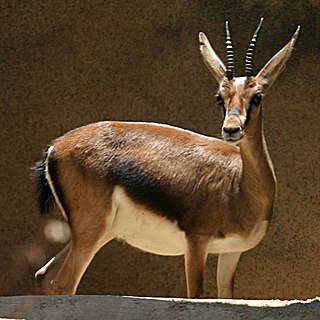 W
WCuvier's gazelle is a species of gazelle found in Algeria, Morocco and Tunisia. It is also known as the edmi. It is one of the darkest species of gazelle in coloring, due to its partial woodland habitat. It is sometimes placed in a separate genus, Trachelocele, from other gazelles, together with goitered gazelles and rhim gazelles. It is very rare in the wild with only 2000 individuals.
 W
WDerby's woolly opossum, or the Central American woolly opossum, is an opossum found in deciduous and moist evergreen forests of Central America, from southern Mexico to western Ecuador and Colombia. It was first described by English naturalist George Robert Waterhouse, and named in honor of Edward Smith-Stanley, 13th Earl of Derby. Derby's woolly opossum is the largest in its genus, with a total length of 60 to 70 centimetres and weight between 200 and 400 grams. The coat is brown and the underside white-buff to golden-brown. The opossum is nocturnal, arboreal (tree-living) and solitary. Diet consists of fruits, nectar, small invertebrates and vertebrates. The time when breeding takes place varies geographically. The litter size ranges from one to six. The IUCN classifies this opossum as least concern.
 W
WThe desert hare is a species of hare found in Northwest China and countries adjacent to it. Little is known about this species except that it inhabits grassland and scrub areas of desert and semi-desert. The International Union for Conservation of Nature has assessed its conservation status as being of "least concern."
 W
WThe eastern forest bat is a species of vesper bat in the family Vespertilionidae. It is found only in Australia, where it has been recorded from Queensland to New South Wales. The population is in decline, with the number of mature individuals decreasing.
 W
WThe eastern hare-wallaby once also known as the common hare wallaby, is an extinct species of wallaby that was native to southeastern Australia. It was first described by John Gould in 1841.
 W
WThe eastern harvest mouse is a species of rodent in the family Cricetidae. It is found only in the United States. Its natural habitats are subtropical or tropical seasonally wet or flooded lowland grassland, swamps, and pastureland.
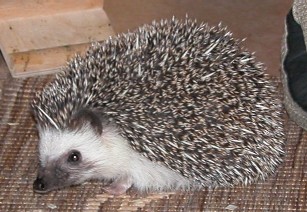 W
WThe four-toed hedgehog, is a species of hedgehog found throughout much of central and eastern Africa.
 W
WGilbert's potoroo or ngilkat is Australia's most endangered marsupial and one of the world's rarest critically endangered mammals. It is a small nocturnal macropod which lives in small groups. It has long hind feet and front feet with curved claws, which it uses to dig for food. Its body has large amounts of fur, which helps with insulation, and its fur ranges between brown and grey, the colour fading on its belly. This potoroo has a long, thin snout curving downward that it uses to smell its surroundings; this trait is common in all potoroo species. Its eyes appear to bulge out of its face and look as though they are on an angle, and its ears are almost invisible, buried under thick fur. Male and female body types are similar and are both within the same size range. Adult females range in weight from 708–1205 g, whereas adult males range in weight from 845–1200 g.
 W
WGould's wattled bat is a species of Australian wattled bat named after the English naturalist John Gould.
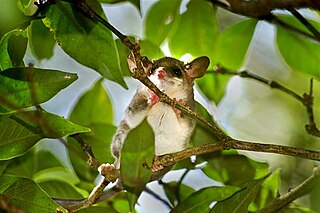 W
WThe gray slender opossum, is an opossum species from Brazil.
 W
WThe Guayaquil squirrel is a tree squirrel endemic to Ecuador and Peru. It is a robust squirrel with a head-and-body length of 18 to 32 cm and a similar length tail. The colour is variable; in Peru, a pale morph is more common, while in Ecuador, most individuals have darker grey fur on the forequarters, dull orange hindquarters. A melanistic morph is sometimes seen. It lives largely in trees and is diurnal, feeding on seeds, flowers, and other plant material, fungi and some insects. These squirrels are also found in urban areas, living in close proximity to humans, and may be vectors for leptospirosis and Chagas disease. This squirrel faces no particular threats, has a wide range and is relatively common, and the International Union for Conservation of Nature has rated it as being of "least concern".
 W
WThe hairy-tailed bolo mouse or hairy-tailed akodont is a South American rodent species of the family Cricetidae. It is found in Argentina, Bolivia, Brazil and Paraguay.
 W
WThe harmless serotine is a species of vesper bat. It has a restricted range in western Ecuador and northwestern Peru. An insectivorous species, it is a resident of tropical dry forest habitat, and is threatened by deforestation.
 W
WThe highlands punaré, Thrichomys inermis, is a caviomorph rodent of South America from the spiny rat family. It is endemic to gallery forest, savanna and rocky outcrop habitats in Bahia State within the Caatinga ecoregion of eastern Brazil at elevations from 260 m to 1030 m. It sometimes nests and often takes refuge in crevices in rock formations, as means of both predator avoidance and moderating temperature extremes. The species tolerates a degree of habitat disturbance. Although hunted, it is considered common throughout its range. Its karyotype has 2n = 26 and FN = 48.
 W
WThe Himalayan marmot is a marmot species that inhabits alpine grasslands throughout the Himalayas and on the Tibetan Plateau. It is IUCN Red Listed as Least Concern because of its wide range and possibly large population.
 W
WThe Himalayan mole is a species of mammal in the family Talpidae.
 W
WThe Japanese marten is a mammal in the marten genus most closely related to the sable. It is 0.5 m (1.5 ft) in length typically, not counting a 20-cm-long tail (7.9 in), and between 1,000 and 1,500 grams in weight. Males are generally larger than females. The pelage varies in color from dark brown to dull yellow with a cream-colored throat.
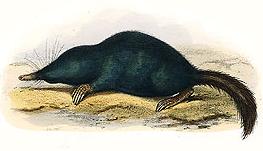 W
WThe Japanese shrew mole or himizu (ヒミズ) is a species of mammal in the family Talpidae. It is endemic to Japan and is found on Honshu, Shikoku, Kyushu, Awaji Island, Shodo Island, Oki Islands, Tsushima Island, Goto Islands, Mishima Island, and Awashima Island, but is absent from Hokkaido, which is north of Blakiston's Line. It is one of three Urotrichini and it is the only species in the genus Urotrichus. It is common between sea level and approximately 2,000 m.
 W
WThe kiang is the largest of the Asinus subgenus. It is native to the Tibetan Plateau, where it inhabits montane and alpine grasslands. Its current range is restricted to plains of the Tibetan plateau and Ladakh, India, and northern Nepal along the Tibetan border. Other common names for this species include Tibetan wild ass, khyang and gorkhar. Travellers' accounts of the kiang are one inspiration for the unicorn.
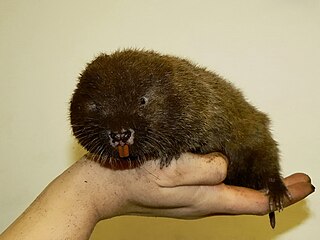 W
WThe lesser bamboo rat is a species of rodent in the family Spalacidae. It is monotypic within the genus Cannomys. It is found in Bangladesh, Bhutan, Cambodia, China, India, Myanmar, Nepal, and Thailand.
 W
WThe mouflon is a wild sheep native to the Caspian region from eastern Turkey, Armenia, Azerbaijan to Iran. It is thought to be the ancestor of all modern domestic sheep breeds.
 W
WMüller's gibbon ,, also known as the grey gibbon, is a primate in the gibbon family, Hylobatidae.
 W
WThe northern grasshopper mouse is a North American carnivorous rodent of the family Cricetidae. It ranges over much of the western part of the continent, from southern Saskatchewan and central Washington to Tamaulipas in northeast Mexico.
 W
WThe northern or sandy nail-tail wallaby is a species of macropod found across northern Australia on arid and sparsely wooded plains. The largest species of the genus Onychogalea, it is a solitary and nocturnal herbivorous browser that selects its food from a wide variety of grasses and succulent plant material. Distinguished by a slender and long-limbed form that resembles the typical and well known kangaroos, although their standing height is shorter, around half of one metre, and their weight is less than nine kilograms. As with some medium to large kangaroo species, such as Osphranter rufus, they have an unusual pentapedal motion at slow speeds by stiffening the tail for a fifth limb. When fleeing a disturbance, they hop rapidly with the tail curled back and repeatedly utter the sound "wuluhwuluh". Their exceptionally long tail has a broad fingernail-like protuberance beneath a dark crest of hair at its end, a peculiarity of the genus that is much broader than the other species. The name unguifera, meaning claw, is a reference to this extraordinary attribute, the purpose of which is unknown.
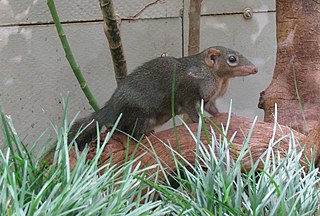 W
WThe northern treeshrew is a treeshrew species native to Southeast Asia.
 W
WThe painted tree-rat is a species of spiny rat from Brazil, restricted to north-eastern Bahia in eastern Brazil. It is the only species in the genus Callistomys.
 W
WThe red-cheeked ground squirrel is a species of rodent in the family Sciuridae. It is commonly referred to as the red-cheeked ground souslik and there are several recognized subspecies. It is found in central Asia. Spermophilus brunnescens, Spermophilus heptneri and Spermophilus ungae are accepted as synonyms. There is some controversy over whether Spermophilus pallidicauda and Spermophilus brevicauda should be regarded as synonyms or full species.
 W
WThe short-eared rock-wallaby is a species of rock-wallaby found in northern Australia, in the northernmost parts of the Northern Territory and Western Australia. It is much larger than its three closest relatives, the eastern short-eared rock-wallaby, the nabarlek and the monjon.
 W
WThe tantalus monkey is an Old World monkey from Africa that ranges from Ghana to Sudan. It was originally described as a subspecies of the grivet. All species in Chlorocebus were formerly in the genus Cercopithecus. It is a common species with a wide range, and the International Union for Conservation of Nature has rated its conservation status as being of "least concern".
 W
WThe Tasmanian devil is a carnivorous marsupial of the family Dasyuridae. It was once native to mainland Australia and was only found in the wild on the island state of Tasmania. It has now been reintroduced to New South Wales with a small breeding population. The size of a small dog, the Tasmanian devil became the largest carnivorous marsupial in the world, following the extinction of the thylacine in 1936. It is related to quolls, and distantly related to the thylacine. It is characterised by its stocky and muscular build, black fur, pungent odour, extremely loud and disturbing screech, keen sense of smell, and ferocity when feeding. The Tasmanian devil's large head and neck allow it to generate among the strongest bites per unit body mass of any extant predatory land mammal. It hunts prey and scavenges carrion, as well as eating household products if humans are living nearby.
 W
WThe urial is a wild sheep native to the Middle East. It is listed as Vulnerable on the IUCN Red List.
 W
WThe water chevrotain, also known as the fanged deer, is a small ruminant found in tropical Africa. It is the largest of the 10 species of chevrotains, basal even-toed ungulates which are similar to deer, but are barely larger than small dogs.
 W
WThe western quoll is Western Australia's largest endemic mammalian carnivore. One of the many marsupial mammals native to Australia, it is also known as the chuditch. The species is currently classed as near-threatened.
 W
WThe yellow-bellied marmot, also known as the rock chuck, is a large, stout-bodied ground squirrel in the marmot genus. It is one of fourteen species of marmots, and is native to mountainous regions of southwestern Canada and western United States, including the Rocky Mountains, Sierra Nevada, and Mount Rainier in the state of Washington, typically living above 2,000 metres. The fur is mainly brown, with a dark bushy tail, yellow chest and white patch between the eyes, and they weigh up to approximately 5 kilograms. They live in burrows in colonies of up to twenty individuals with a single dominant male. They are diurnal and feed on plant material, insects, and bird eggs. They hibernate for approximately eight months starting in September and lasting through the winter.